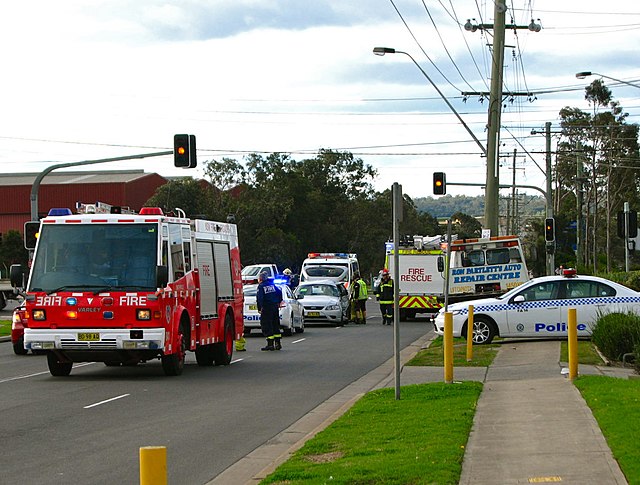Loading AI tools
Organizations that ensure public safety and health by addressing different emergencies From Wikipedia, the free encyclopedia
Emergency services and rescue services[1] are organizations that ensure public safety, security, and health by addressing and resolving different emergencies. Some of these agencies exist solely for addressing certain types of emergencies, while others deal with ad hoc emergencies as part of their normal responsibilities. Many of these agencies engage in community awareness and prevention programs to help the public avoid, detect, and report emergencies effectively. Emergency services are often considered first responders, and typically have dedicated emergency vehicles.

Emergency services have one or more dedicated emergency telephone numbers reserved for critical emergency calls. In many countries, one number is used for all of the emergency services (e.g. 911 in many parts of the Americas, 999 in the United Kingdom, 112 in continental Europe, 000 in Australia). In some countries, each emergency service has its own emergency number (e.g. 110 for police, 118 for coast guard, 119 for fire and medical in Japan; 110 for police, 119 for fire, 120 for medical in China). Calls made to emergency services to report emergencies are called calls for service.
The availability of emergency services depends very heavily on location, and may in some cases also rely on the recipient giving payment or holding suitable insurance or other surety for receiving the service.

Primary emergency services are emergency services that provide basic emergency assistance and care. They can be summoned directly by the public. There are three primary emergency services and they are listed in the following order.




Specialized emergency services are emergency services that are not considered one of the three primary emergency services. They can be provided by one of the primary emergency services (often as a division or unit) or by a separate governmental or private body.
Specialized emergency services may typically be contacted and requested by the public, unless they are a division or unit of a primary emergency service. They may also often be requested by primary emergency services to handle certain emergencies or augment existing emergency services personnel. Some of these services may be location-specific and have jurisdiction over specific areas or situations, with little if any authority outside them.
In some jurisdictions, specialized emergency services may be allowed to use emergency lights on their vehicles, often yellow or amber lights unless they are already part of a primary emergency service, in which case they typically use the emergency lighting configuration used by their respective emergency service.

Effective emergency service management requires agencies from many different services to work closely together and to have open lines of communication. Most services do, or should, have procedures and liaisons in place to ensure this, although absence of these can be severely detrimental to good working. There can sometimes be tension between services for a number of other reasons, including professional versus voluntary crew members, or simply based on area or division. To aid effective communications, different services may share common practices and protocol for certain large-scale emergencies. In the UK, commonly used shared protocols include CHALET and ETHANE while in the US, the Department of Homeland Security has called for nationwide implementation of the National Incident Management System (NIMS),[2] of which the Incident Command System (ICS) is a part.[3]
Smart Emergency Response System (SERS)[4] prototype was built in the SmartAmerica Challenge 2013–2014,[5] a United States government initiative. SERS was created by a team of nine organizations. The project was featured at the White House in June 2014 and called an exemplary achievement by Todd Park (U.S. Chief Technology Officer).
The SmartAmerica initiative challenges the participants to build cyber-physical systems as a glimpse of the future to save lives, create jobs, foster businesses, and improve the economy. SERS primarily saves lives. The system provides the survivors and the emergency personnel with information to locate and assist each other during a disaster. SERS allows organization to submit help requests to a MATLAB-based mission center connecting first responders, apps, search-and-rescue dogs, a 6-feet-tall humanoid, robots, drones, and autonomous aircraft and ground vehicles. The command and control center optimizes the available resources to serve every incoming requests and generates an action plan for the mission. The Wi-Fi network is created on the fly by the drones equipped with antennas. In addition, the autonomous rotorcrafts, planes, and ground vehicles are simulated with Simulink and visualized in a 3D environment (Google Earth) to unlock the ability to observe the operations on a mass scale.[6]

A common measurement in benchmarking the efficacy of emergency services is response time, the amount of time that it takes for emergency responders to arrive at the scene of an incident after the emergency response system was activated. Due to the nature of emergencies, fast response times are often a crucial component of the emergency service system.[7]
Seamless Wikipedia browsing. On steroids.
Every time you click a link to Wikipedia, Wiktionary or Wikiquote in your browser's search results, it will show the modern Wikiwand interface.
Wikiwand extension is a five stars, simple, with minimum permission required to keep your browsing private, safe and transparent.